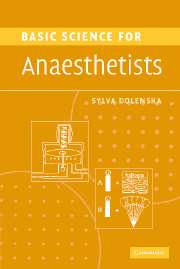Book contents
- Frontmatter
- Contents
- List of abbreviations and symbols
- List of figure captions
- Forewords
- Preface
- Preface to the second edition
- Part 1 Physics, mathematics, statistics, anaesthetic apparatus
- 1 Gas compression, relationship of volume, pressure and temperature
- 2 Real gas compression
- 3 Flow and resistance
- 4 Heat, vaporization and humidification
- 5 Simple mechanics 1: mass, force, pressure
- 6 Simple mechanics 2: work and power
- 7 Mathematical concepts
- 8 Exponentials 1: the curves
- 9 Exponentials 2: properties of exponential decay curve
- 10 Descriptive statistics
- 11 Presentation of data
- 12 Receiver operating characteristic curve
- 13 Gas supply and pressure
- 14 The circle system
- 15 The Mapleson A (Magill) breathing system
- 16 T-pieces
- 17 Lung filling with automatic lung ventilators
- Part 2 Clinical measurement
- Part 3a Physiology: the cardiovascular system
- Part 3b Physiology: the respiratory system
- Part 4 Pharmacology
- Further Reading
- Index
13 - Gas supply and pressure
from Part 1 - Physics, mathematics, statistics, anaesthetic apparatus
Published online by Cambridge University Press: 13 August 2009
- Frontmatter
- Contents
- List of abbreviations and symbols
- List of figure captions
- Forewords
- Preface
- Preface to the second edition
- Part 1 Physics, mathematics, statistics, anaesthetic apparatus
- 1 Gas compression, relationship of volume, pressure and temperature
- 2 Real gas compression
- 3 Flow and resistance
- 4 Heat, vaporization and humidification
- 5 Simple mechanics 1: mass, force, pressure
- 6 Simple mechanics 2: work and power
- 7 Mathematical concepts
- 8 Exponentials 1: the curves
- 9 Exponentials 2: properties of exponential decay curve
- 10 Descriptive statistics
- 11 Presentation of data
- 12 Receiver operating characteristic curve
- 13 Gas supply and pressure
- 14 The circle system
- 15 The Mapleson A (Magill) breathing system
- 16 T-pieces
- 17 Lung filling with automatic lung ventilators
- Part 2 Clinical measurement
- Part 3a Physiology: the cardiovascular system
- Part 3b Physiology: the respiratory system
- Part 4 Pharmacology
- Further Reading
- Index
Summary
Medical gases supplied in cylinders are compressed to a high pressure in order to store a big mass in a relatively small volume (it follows from Boyle's law that the higher the pressure inside the cylinder, the bigger the final volume of decompressed gas). The human respiratory system operates at low pressures; high pressure can produce barotrauma. Gas supply pressure has to be reduced in stages and safety features are incorporated. The wide range of pressures in the medical gas supply and in the breathing system has led to the establishment of various units suiting each particular purpose: bars for high pressures, lb/psi for moderate pressures, mmHg for atmospheric and lower pressures, and cmH2O for very low pressures measured as a column of water. (See more on gas pressure in the chapter on real gas compression, and on units in simple mechanics.)
Figure 44 shows the pressures inside the gas supply system on a logarithmic scale; in this way, it is possible to include a wide range of pressures in one graph. In particular, notice that the gas supply operates in terms of hundreds of kPa (bars) but the breathing system pressures are kPa units or their fractions. The logarithmic scale of the ordinate also demonstrates that each stage of decompression reduces the pressure very approximately by a factor of 10.
The volume shown on the abscissa is that which would be obtained by decompression of 1 litre gas at the pressure indicated to atmospheric pressure.
- Type
- Chapter
- Information
- Basic Science for Anaesthetists , pp. 52 - 53Publisher: Cambridge University PressPrint publication year: 2006



